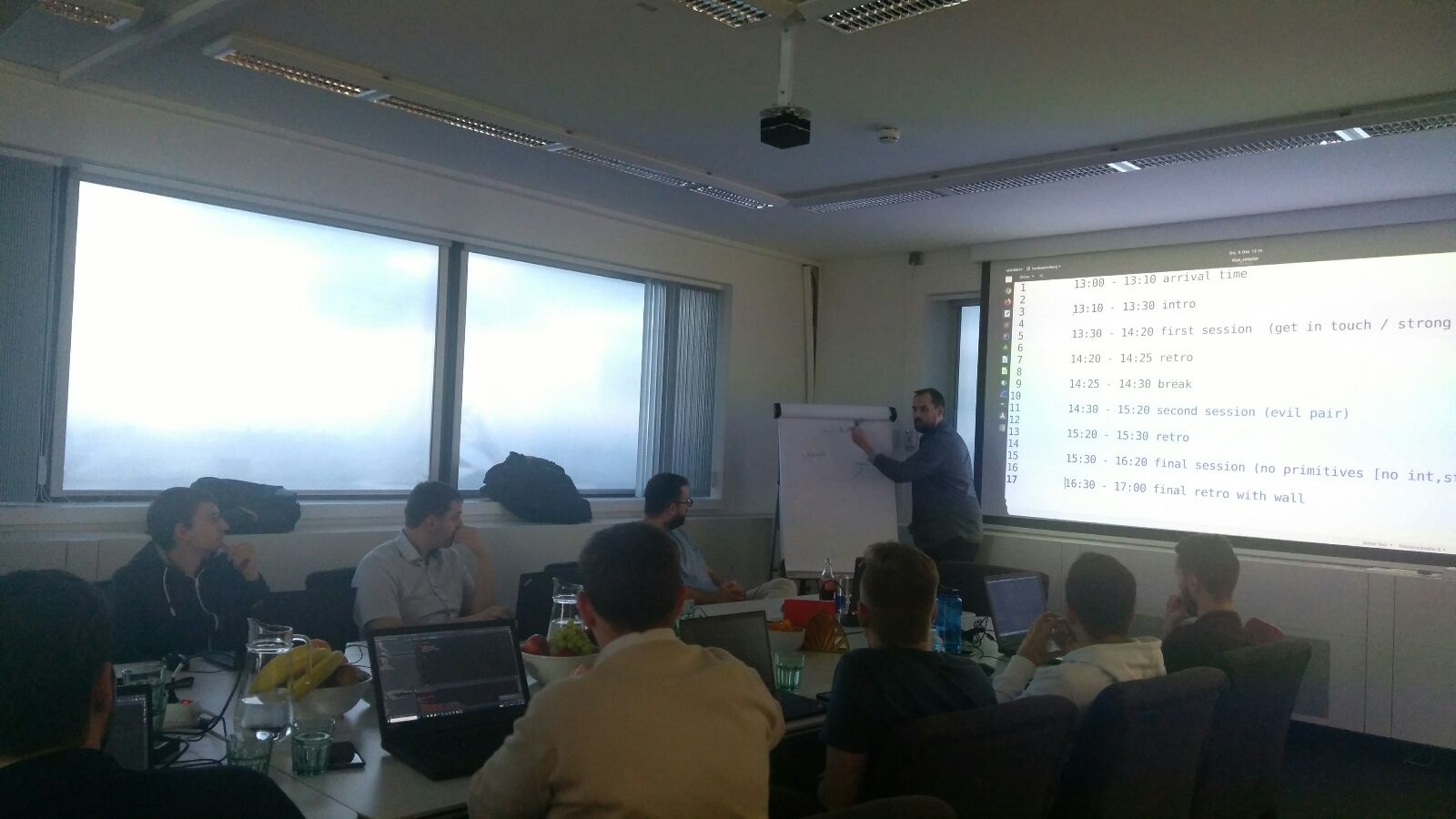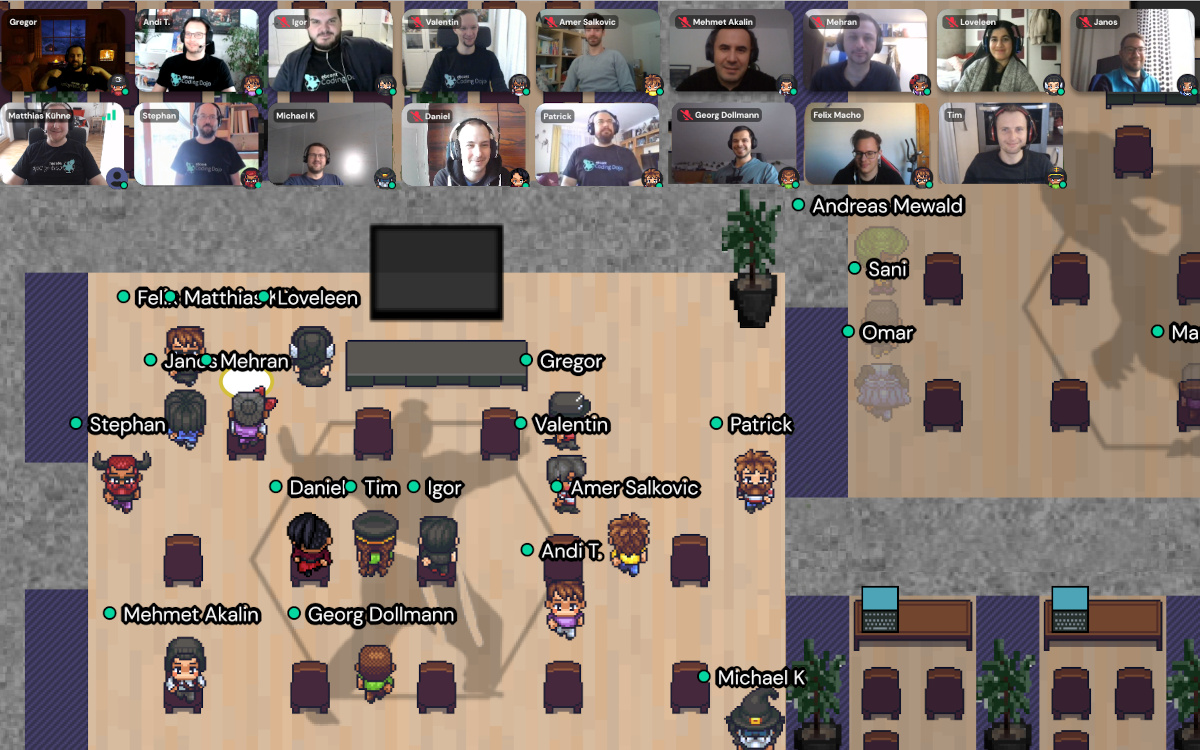Two years ago, in 2019, I ran the first Coding Dojo at my company EBCONT. Corona wasn’t a thing back then, so it happened to be an offline event that lasted 4 hours on a Thursday afternoon. All the brilliant people came together to practice programming and enjoyed it. How awesome is that?

A lot has changed since then. When the pandemic happened, I had to adapt and move it online. So I decided to make it a regular remote whole-day event. Luckily I had already collected plenty of experience from my friends at the Vienna Software Crafts Community where we also run Coderetreats.
The EBCONT Coding Dojo turned out to be a small success story. When I started it, I had approximately ten people join, many of which became regular attendees. But lately, there was a small hype around the event. People liked it so much that they came up with the idea to create a Coding Dojo T-Shirt and shoot a group photo with it. Of course, we did so. I had 25 employees join in the latest event, and it was a lot of fun.

Again, take a closer look at these sweet t-shirts! :-)

Coding Dojo???
So what is a Coding Dojo, how do I do it, and what can you take away from my experience? The term Dojo originates in Japan and stands for a training facility where they perform katas, choreographed patterns of martial art movements designed for practice.
A Coding Dojo is a similar thing. We just perform coding katas. It is a great opportunity to practice technical skills like TDD, design, and refactoring. Invaluable fundamentals that are mostly not taught in school. They are left behind the things that turn out to have higher demand: Frameworks and tools.
Under pressure, we naturally fall back to old and maybe poor habits, even though it leads to worse results. So we take our time to practice and get comfortable with better programming techniques and to be confident to apply them when it counts. While the traditional Coding Dojo is a short ~2-hour event, the one I do lasts almost a whole day.
The Coding Dojo creates space for developers to practice the fundamentals of programming, away from the pressure of getting things done.
But why not a full day?
An intense full-day practice event can become tiring in my experience. Closing just a little bit sooner leaves everybody more energy for the final retrospective and the evening after the event. There are similar whole-day events in the name of Coderetreat and Mobretreat. The classical Coderetreat has the notion of throwing away your code after a timeboxed session and starting from scratch with a different pair. So you don’t finish, but get to see many different perspectives within a short time - quite intense. That’s a little different from what I do. I like to provide the participants the opportunity to dive deeper into a kata. So we stay within the same teams and kata throughout the day. This reduces the relative amount of setup time, which allows us to get more coding done.
The Dojo plan
I decide on the topic and kata in advance, taking the attendees’ skill levels into account. Before the event, I send them information about what we’ll be working on. The Dojo starts with a short welcome where we have a few minutes of small talk before the intro session begins. In the intro session, we discuss the topic and kata. I like to walk over a minimum of the theory that I believe everybody should know. One effective way to do this is to keep asking questions so they provide the answers themselves. At the end of the intro session, we form the teams whose be working together in the following coding sessions.
Balancing teams
I want less experienced people to learn from more experienced people. But that doesn’t mean more experienced ones won’t learn. They deepen their understanding as they communicate their ideas. Curious participants may even challenge their thinking and help them to refresh or even reset. So I like to balance the skill levels among the teams while also taking into account their desired programming language. The tool I use Gather-Town helps me with that.
Gather-Town is a remote video conference tool that works like a multiplayer version of Zelda. You can move around on a 2d map and talk to people in your vicinity. It creates that feeling of meeting somebody at a conference in the hallway again, just online. And it allows us to split up and go to different rooms. Also, it gives me the freedom to customize the map. I use an altered version of a map that Christian Haas once made for Viennas Global Day of Coderetreat.
I ask the people to assess their abilities and to take a position in the room that matches their confidence to work on the given kata. Standing on the right end of the room means “very confident” and the left end means “I’m lost”. The rest of the spectrum is in between. This creates an overview that makes it fairly easy to form balanced teams. In my opinion, the optimal team size is 3, but 4 works too. For bigger teams, you might want to assign a designated facilitator.
Tip: Assign a facilitator for a team
It is not possible for me as a single person to facilitate the programming in every team. Especially when the people are not used to collaborative coding it makes sense to assign a designated facilitator. The responsibility of this person is to provide just enough guidance for the team to work well together. This can be anyone who knows a bit of mob programming. The role can be rotated so that everybody gets the chance to contribute. When the team is small and most people are already used to this, a facilitator might not be necessary.
Coding sessions & retrospectives
Typically we manage to have three coding sessions, each of which is followed by a short retrospective. In these retros, we discuss anything interesting. How we feel, what we discovered and learned, and how we approached the exercise. We might also share and review the code we had written so far.
The first session always includes setup, which is the time spent until the team starts coding together in some way. Somehow, setup always takes a fair amount of time - regardless of how well prepared you are. The goal is to minimize this time and maximize coding time. There are lots of ways to code together quickly, and you probably already have some in mind. However, I would like to share some ways with you I found work well.
#1 Single Driver Mode
A way to get to code quickly is to have just a single person who already has a setup prepared to share their screen. The downside of this is the risk of other people falling behind due to inactivity. The avoid that, the person sharing should behave as a passive driver while the other people make decisions and rotate the navigator role. I prefer when everybody gets to drive, but this usually takes more setup time.
#2 Cyber-Dojo
Cyber-Dojo.org works well for TDD katas, as it allows you to create and share a browser-based setup for any language in no time. However, it won’t provide you with all the conveniences your IDE does. Things like continuous compilation, autocompletion, automated refactoring, and so on are not available.
#3 Virtual dev environment
Another way to get to code together quickly is to join the same virtual development environment. It could be a virtual machine running in the cloud where everything is already set up. People would connect to it through some remote desktop software. I prepared something like this, where I can spawn an immutable Linux dev system on Azure: Remdev on Azure
A typical schedule
This is what my typical schedule would look like:
- 08:50 - 09:10 - Welcome
- 09:10 - 09:40 - Theory, Details
- 09:40 - 10:50 - First Coding Session
- 10:50 - 11:00 - Short Break
- 11:00 - 12:30 - Second Coding Session
- 12:30 - 13:30 - Lunch Break
- 13:30 - 14:50 - Third Coding Session
- 14:50 - 15:30 - Retro
Coding sessions already include 10-20 minutes of retro time. While it’s not a big deal to be a little late in the schedule, I want to nail the 1-hour lunch break. This allows people to plan and spend that time with their families.
My role as a facilitator
As a facilitator, I am not there to actively perform katas. Instead, my job is to make sure that every participant gets the chance to learn and practice. So I am merely the organizer and enabler. I watch out that we keep the schedule (which I’m terrible at) and mostly try to get out of the peoples’ way. Also, I’m there to help the participants when they get stuck or have questions. But this doesn’t mean I’m not learning. Quite the opposite is true. I learn a lot as I get to see amazing ideas, experience new tech, observe sociotechnical patterns, discover and rediscover non-obvious details.
During the coding sessions, I switch from team to team and observe what they’re up to. This works well with Gather-Town as I can literally walk from room to room. Occasionally I see things I am concerned with and bring that up. I try to do this by asking questions, sparking their creativity, and having them come up with their own solutions. Or I may see something interesting, for example, a pattern emerge that I find worthy of a discussion, so everybody understands. If you want to learn more about facilitation in this regard I recommend Peters Coderetreat-Facilitation Podcast. Many of the things I’m doing are things I learned from him.
Choosing a kata/topic
The Coding Dojo should be a place to practice the fundamentals. The perfect kata is not too hard for the attendees to tackle, is small enough to finish within the event, and is one that you as a facilitator already know well. But it doesn’t have to be perfect. As a refactoring exercise, I like the Expense Report Kata which is nice and small. Or the Order Dispatch Kata which is about Tell don’t ask. As for TDD katas I liked Snake, Game of Life, or Mars Rover. But I also did completely different things. For example, the Elephant Carpaccio Exercise which is about vertical story slicing and iteration.
Selling your Coding Dojo
If you want to start a Coding Dojo at your company, let me tell you that I think that’s awesome! I’d recommend getting your boss to agree that it will happen during the work-day and that it will be considered work-time. Missing know-how is a bottleneck in our industry, where the majority have less than five years of experience. Fresh developers have to learn so many things about their tech, tools, and frameworks these days, that there is little room left for programming fundamentals like TDD and refactoring. Some of those are mostly not taught in school either. When people get to practice these, they become better programmers. They get better at writing code that works, is more maintainable, and more secure, in less time. What boss wouldn’t want that?
Conclusion
The Coding Dojo is a great and fun way to provide developers with the space they need to get better at their job. People enjoy learning from one another in a relaxed environment like this. I’m proud of the progress participants have made so far at my Dojo. Feel free to contact me if you have questions, or if you would like to start a similar event. And if you already have something like this at your company, I would love to hear about that, too.